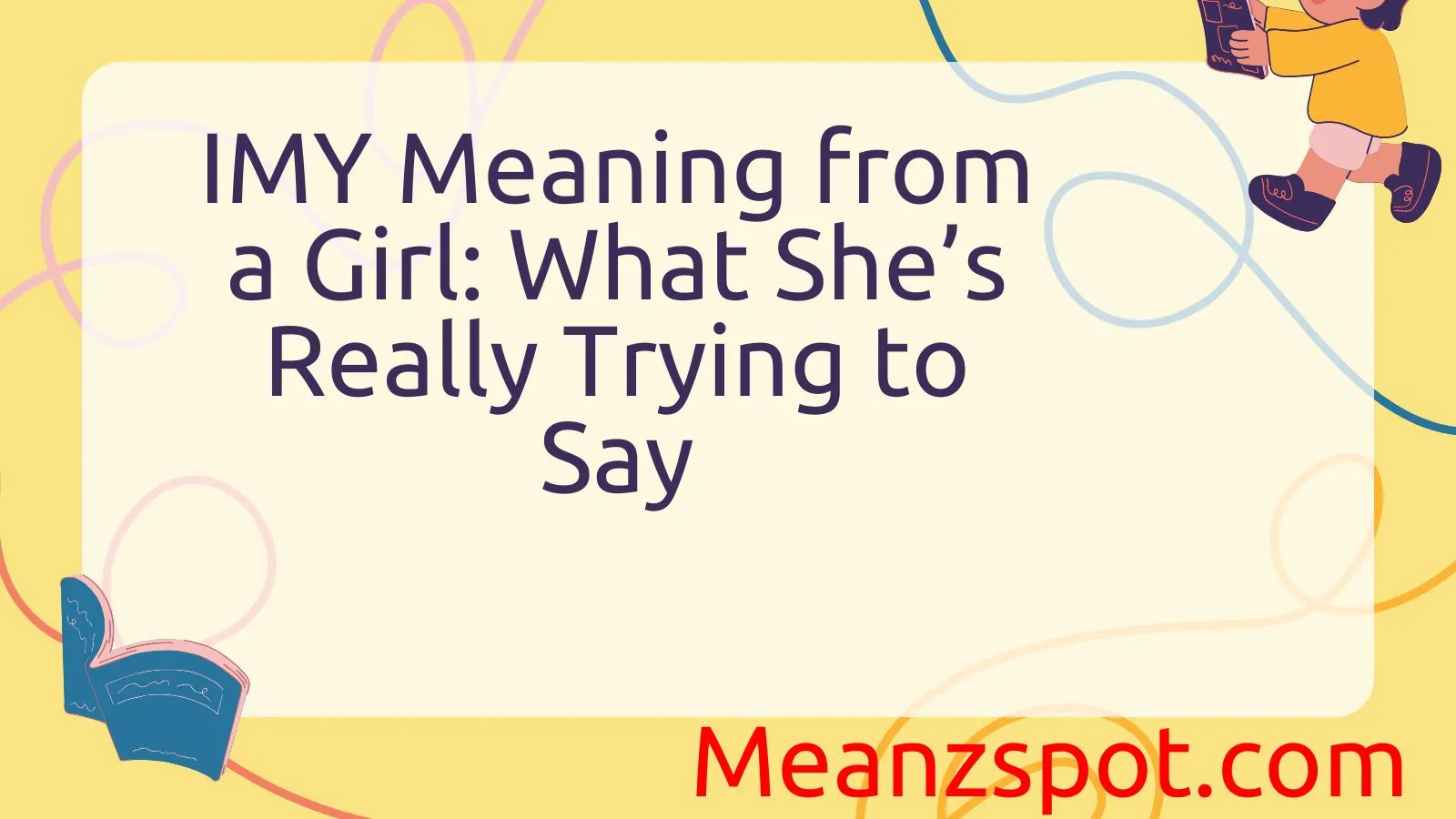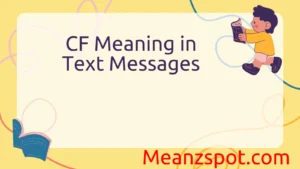In today’s texting culture, three-letter acronyms can say a lot—and IMY is no exception. If a girl texts you IMY, it might seem simple, but there’s often more emotion behind it than meets the eye.
IMY stands for “I Miss You,” and while that might seem straightforward, the meaning can shift based on who sent it, when, and how. Whether it’s a romantic partner, a crush, or just a friend, the context and tone matter just as much as the words themselves.
This trending phrase has become a go-to expression in 2025 for showing affection, starting conversations, or rekindling a connection. In this updated guide, we’ll break down what IMY means specifically when a girl says it, how to interpret it, and what your next move should be.
Definitions & Meaning
IMY stands for “I miss you.” It’s a casual, shorthand way to express longing or affection toward someone who’s not currently present. This phrase is most commonly used in text messages, direct messages (DMs), or social media chats to convey emotional warmth and connection.
When a girl texts “IMY,” it usually indicates that she’s thinking about you and wishes you were around. Depending on your relationship dynamic, it could be a friendly check-in, a subtle romantic hint, or an open expression of emotional closeness. Unlike the formal “I miss you,” the abbreviated form feels lighter and more casual, which is why it’s often used in texting.
Example Scenarios:
- From a girlfriend: “Hey, just thinking about you… IMY ❤️”
- From a close friend: “It’s been forever since we hung out—IMY!”
- From a crush: “You were so fun to talk to last night… IMY 😊”
Tone, timing, and accompanying emojis or context play a big role in interpreting the intent behind the message.
Origins & History
The abbreviation “IMY” emerged as part of the growing trend of internet and texting shorthand, which began gaining traction in the late 1990s and early 2000s. With the rise of SMS messaging, users were limited by character counts and often had to be creative in shortening commonly used phrases. Abbreviations like “LOL” (laugh out loud), “BRB” (be right back), and “IMY” (I miss you) became popular.
IMY became especially common with the rise of mobile phones, chat rooms, and later, messaging apps like WhatsApp, Messenger, and Snapchat. As people began communicating more via typed messages rather than phone calls or letters, shortcuts became a necessity—and also a cultural phenomenon.
In recent years, IMY has evolved beyond mere convenience. It’s now a widely recognized emotional cue, often used to maintain emotional closeness in long-distance friendships and romantic relationships. Unlike “I miss you,” which can feel formal or heavy in certain contexts, “IMY” allows for a gentler, softer delivery of the same sentiment.
Usage in Different Contexts
The way “IMY” is used can vary greatly depending on the platform, tone, and relationship between the sender and recipient. Here’s a breakdown of how it appears in different communication contexts:
1. Social Media
On platforms like Instagram, Twitter, or TikTok, IMY often appears in captions or comments:
- “This throwback is everything. IMY 😢”
- “Shoutout to my bestie. IMY, girl! 💕”
These uses tend to be more public and may reflect platonic affection or nostalgia.
2. Private Texting
In personal messages, especially one-on-one conversations, IMY can take on a more intimate tone:
- “I’ve had such a long day… IMY.”
- “Saw something today that reminded me of you. IMY.”
When a girl sends this via private chat, it’s likely more emotionally driven, hinting at deeper feelings.
3. Pop Culture
IMY is also frequently used in music, movies, and television scripts. Lyrics and dialogue often include the phrase to convey emotional vulnerability or romantic longing:
- “IMY so much it hurts.”
This normalization through pop culture further solidifies its emotional depth and relatability.
4. Professional or Casual Acquaintances
While less common in professional settings, IMY can appear among coworkers or classmates who share a personal bond:
- “Haven’t seen you at meetings lately. IMY!”
Here, it’s more of a light-hearted expression rather than romantic or deeply emotional.
The context always determines the weight of the message. If you’re unsure how to interpret it, consider the relationship and any prior interactions.
Common Misunderstandings & Clarifications
While “IMY” seems straightforward, it’s often misread or misinterpreted—especially when emotions are involved. Let’s look at some common misunderstandings:
1. Assuming Romance
Just because a girl texts “IMY” doesn’t always mean she’s in love or wants a relationship. It could simply mean she enjoys your company or misses talking to you.
Clarification: Context is key. Look at how often she says it, how she says it, and what your previous conversations have been like.
2. Thinking It’s Passive or Dismissive
Some people might assume that using the abbreviation rather than the full “I miss you” is less sincere.
Clarification: IMY is often used for convenience and brevity. It doesn’t necessarily dilute the emotional value.
3. Overanalyzing Emojis or Lack Thereof
If a girl writes “IMY” with no emojis, some may interpret that as cold or indifferent.
Clarification: Emoji usage varies from person to person. Some people express themselves with words, not symbols.
4. Expecting a Response
Sometimes people feel obligated to respond in a certain way, especially if they’re unsure how they feel.
Clarification: A reply isn’t mandatory. You can acknowledge the message without reciprocating if your feelings differ.
By keeping these nuances in mind, you can avoid jumping to conclusions and instead respond appropriately based on your understanding of the relationship.
Alternatives & Synonyms
While “IMY” is common, there are many other ways to express the sentiment of missing someone in text:
1. Full Phrase:
- “I miss you” – More formal or emotionally weighty.
2. Other Abbreviations:
- ILYSM – I love you so much (often paired with IMY).
- MYS – Miss you so (less common).
- IMYT – I miss you too.
3. Emojis as Substitutes:
- 😢💔 – Indicates sadness or missing someone.
- 🥺 – Often used to add emotional tone to a simple “IMY.”
4. Creative or Personalized Phrases:
- “Thinking about you a lot lately.”
- “Wish you were here.”
- “Can’t wait to see you again.”
Different people have different texting styles. The important part is the emotion behind the message, not necessarily the format. If a girl switches between “IMY” and other forms of affection, it usually reflects comfort and closeness in your relationship.
Frequently Asked Questions
Q1: What should I reply when a girl texts “IMY”?
A: If you feel the same, a simple “IMY too 😊” works well. If you’re unsure, a friendly “Aww, that’s sweet. Miss chatting with you too!” is a safe middle ground.
Q2: Does “IMY” always mean she likes me romantically?
A: No. It could indicate friendship, care, or nostalgia. The overall tone of your conversations will offer better clues.
Q3: Is it okay to say “IMY” first to a girl?
A: Absolutely. As long as it’s sincere, it’s a warm way to show you care. Just make sure it matches the level of your relationship.
Q4: How often is too often to say “IMY”?
A: Saying it too frequently may dilute its meaning. Use it when you genuinely feel it, not out of habit.
Q5: Can “IMY” be used in a professional setting?
A: It’s best avoided in strictly professional contexts. However, between coworkers who are also friends, it might be acceptable informally.
Q6: Is “IMY” used more by girls than guys?
A: While anyone can use it, it is more commonly seen in messages from girls due to its emotional expressiveness. That said, it’s not gender-exclusive.
Q7: What does it mean if she sends “IMY” late at night?
A: Nighttime texts can carry extra emotional weight. It might mean she’s feeling sentimental or especially close to you at that moment.
Conclusion
“IMY” might be short, but it carries significant emotional weight depending on who’s saying it and how. When a girl sends you this message, it often means she’s thinking about you and values your presence—whether as a friend, a romantic interest, or someone she misses talking to. Understanding the context, relationship dynamics, and accompanying cues (like emojis or timing) can help you interpret the true sentiment behind those three letters.
In a world where digital communication is increasingly nuanced, being able to decode phrases like “IMY” helps foster clearer, more meaningful connections. Whether you’re texting back with “IMY too” or reflecting on her intent, your response can strengthen your bond—one message at a time.



